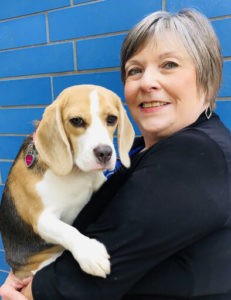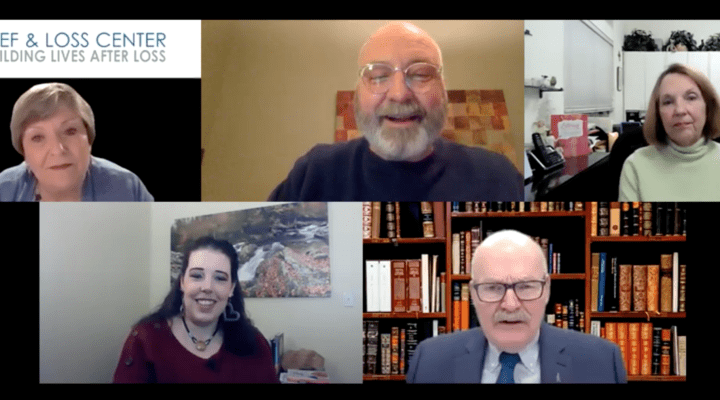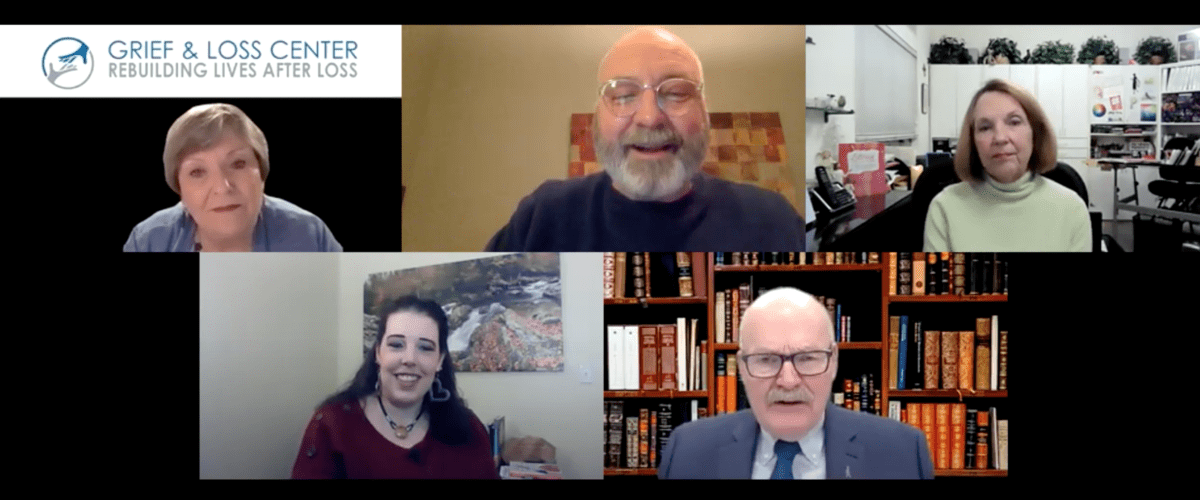The COVID-19 pandemic has imbued grieving and isolation with deeper, darker shades during the 2020 holiday season, a panel of experts said during a Dec. 3 webinar hosted by Baptist News Global.
The pain of suffering loss or, for LGBTQ persons, the rejection by family, are exacerbated without the usual access to friends, family, churches and counseling.

Laurie Taylor with her grief therapy dog, Hope.
“It’s really hard right now to find a new normal. Everything is abnormal,” said panelist Laurie Taylor, a former Baptist minister who leads the Grief and Loss Center of North Texas.
Taylor and fellow panelists Harold Ivan Smith, Amber Cantorna and Phawnda Moore participated in BNG’s “Creative Approaches to Pandemic Holidays” to present not only the emotional challenges imposed by the coronavirus outbreak, but also to share solutions to the isolation and despondency.
Their 75-minute discussion was moderated by BNG Executive Director Mark Wingfield and included the pandemic’s impact on the grieving process, lessons from history and the benefits of activity and music in handling the stressors of the virus-impacted holiday season.
‘A great challenge’
Taylor said those struggling with grief, always more difficult at the holidays, are finding it made worse because of the loss of touch imposed by COVID-19. “Our clients need hugs, and they can’t get hugs.”
One consequence of that dynamic is an even greater reluctance by many people to face their grief at all, said Smith, a grief counselor and scholar whose research focuses on the grief of U.S. presidents and first ladies.

Harold Ivan Smith
There is always a tendency to attempt to avoid the painful feelings that accompany grief. But Smith and his colleagues are seeing an increase in “submerged grief,” which they compare to an iceberg. “We are dealing with 10% above the waterline and no one knows how deep the iceberg goes.”
Grief also is expressed through the collective pain of LGBTQ people quarantined in homes with non-affirming family members, said Cantorna, a Christian musician, writer and speaker based in Denver.
Those individuals are grieving the loss of friends, churches and others who accept them for who they are, said Cantorna, also a regular BNG columnist and the author of two books, Refocusing My Family and Unashamed: A Coming Out Guide for LGBTQ Christians.
“That has been a great challenge for a lot of LGBT people,” she explained.
However, she added that the social isolation for many LGBTQ people will continue even after the pandemic abates due to continued rejection by family. What everyone in America is experiencing in isolation right now “is their normal.”
‘Art and grief are so genuinely blended’
Healing from all forms of isolation and despair can be found in simple-but-meaningful art activities, said Moore, a professional calligrapher and artist and a regular BNG columnist.

Phawnda Moore
The California resident suggested creating and sending artistically decorated envelopes, postcards and notes to family, friends and even delivery people. Moore said she gives cards addressed with calligraphy to her husband and others close by.
Healing through such a tactile activity comes not from the level of artistic expertise but from the activity itself and from the intent to connect with others, she said. “You don’t have to be overly creative in terms of skill but it’s a matter of expressing yourself with words and colors.”
Smith added he’s heard of people struggling over whether to send cards and other condolences. Moore responded: “You should send them. Especially this year.”

Amber Cantorna
Cantorna said spending time in nature and a newly acquired photography hobby have already helped her and her wife cope with the isolation imposed by the coronavirus. The couple recently spotted a herd of bison with the Rocky Mountains as a backdrop. She captured and edited images of the scene, a process she found inspiring.
“I thought, ‘I have got to make more time for this.’ It just lifted my soul in ways I hadn’t felt in weeks or months.”
Helping others also helps pull you away from grief, said Cantorna, who launched an online book club for LGBTQ friends from around the nation and world. “A beautiful community of people have been able to find support for one another in that space.”
Smith said he’s found making homemade peanut butter balls to be therapeutic for him, especially after a night working with grief groups. The idea is then to give them to others. “The fact that it’s homemade has a special ring to it.”
Activities that don’t require speaking also can be special to those who are grieving, because “grief has no words,” Taylor said.
Activities that don’t require speaking also can be special to those who are grieving, because “grief has no words.”
The Grief and Loss Center of North Texas, she said, includes art and other activities to help clients express the pain and devastation they are feeling.
One of these activities is making votive candle holders with colored paper and glue. “Art and grief are so genuinely blended and it’s such a healing process,” she said.
‘I sobbed as a little girl’
Panelists added that music can have a similar effect for those struggling with loss and loneliness.
“It allows us to express our grief,” Cantorna said. “It allows us to process and let go of things. Music can be a very healing form of art.”
Taylor said she has counseled those who cannot bear to listen to music while grieving, while others “turn on the music and the tears flow and they get it out. It’s amazing.”
History also teaches some amazing lessons about the importance of healthy grieving, including during pandemics, the panelists said.
Smith relayed the experience of former President Andrew Jackson, whose wife, Rachel Jackson, died shortly before his inauguration in 1829.
Smith relayed the experience of former President Andrew Jackson, whose wife, Rachel Jackson, died shortly before his inauguration in 1829, causing him so much pain he considered not going through with the inauguration.
President Calvin Coolidge lost his 16-year-0ld son to blood poisoning in 1924. The First Family gathered around a piano on Christmas Eve to sing the boy’s favorite Christmas carols, Smith said.
Warren G. Harding’s 1920 presidential campaign slogan, “return to normalcy,” captured the nation’s desire to bypass the collective grief associated with the overlapping deaths in World War I and the 1918 Spanish flu pandemic, he added.
Next came the “highly emotional time” of the Roaring ’20s, a period when a lot of children reported nightmares from the war and flu outbreak. “You can’t sweep grief under the rug,” Smith said.
Taylor said her own connection to grief also began with a historical death, that of prematurely born Patrick Bouvier Kennedy, son of John F. and Jacqueline Kennedy in 1963. The boy was barely 2 days old when he died.
“That’s my first recollection of actually mourning and grieving,” she said. “I sobbed as a little girl.”
The event helped inspire Taylor eventually to minister to others experiencing grief. But in that childhood experience, she also learned that Americans aren’t big fans of the emotional process.
‘Hug that cactus’
Also facing great challenges are persons in recovery who often turn to alcohol or drugs to cope with death or loneliness, Smith said. “We want to medicate the pain rather than walk into it.”
But addicts aren’t alone in that impulse, he added. “People will do anything to dodge grief. But it’s like that iceberg: it’s going to come around to get you.”
That’s why Taylor said she encourages grieving individuals to embrace their grief rather than try to avoid or minimize it.
“Grief is like a cactus. It’s painful, and I ask people to hug that cactus.”
“We call it hugging the cactus,” she said. “Grief is like a cactus. It’s painful, and I ask people to hug that cactus.”
Embracing painful feelings and memories leads to true healing, she explained. “That cactus is going to morph into a Teddy bear. Grief will become the comfort it’s meant to be.”
‘It just takes being creative’
Grieving or not, panelists agreed it’s a good idea to have a plan for Christmas and this unusual holiday season. This is a lesson Cantorna said she has learned since being disowned by her biological family for being gay. Even before the pandemic, getting through the emotions of the holidays worked best if she had a plan laid out in advance.
That includes planning exercise, getting outside and being of service to others in dark times.
Even dropping a gift at the front porch will offer a point of connection.
“Taking care of one another is very important this season,” Cantorna said, reporting that she plans to provide food plates to friends and connect with others who are isolated and struggling. Even dropping a gift at the front porch will offer a point of connection, she said.
For those grieving deaths this year due to COVID or other reasons, the panel recommended speaking their grief in various ways. For example, it often helps to write letters to departed loved ones, and even to read them at gravesides, as a means of expressing closure that was missing.
Smith said he’s recommended people leave cookies at gravesides. Taylor shared about an 8-year-old boy who left a Valentine’s Day card at his father’s grave and plans to leave a Christmas tree there this month.
Moore said it’s easy to fall into despair believing the pandemic will never end. But not only will this pass, it can be a constructive time if it is faced head-on, she said. “If we make memories of this time, good and bad, it will be valuable to us down the road.”
Doing so requires just a little thought on caring for self and others, Cantorna said. “It just takes being creative and being outside the box a little bit.”
And for those grieving, Taylor said it means not surrendering to despairing thoughts. “It’s not a question of if you can get through the holiday — you are doing it. Just remember you are loved and you are not alone.”
Watch the webinar here.


